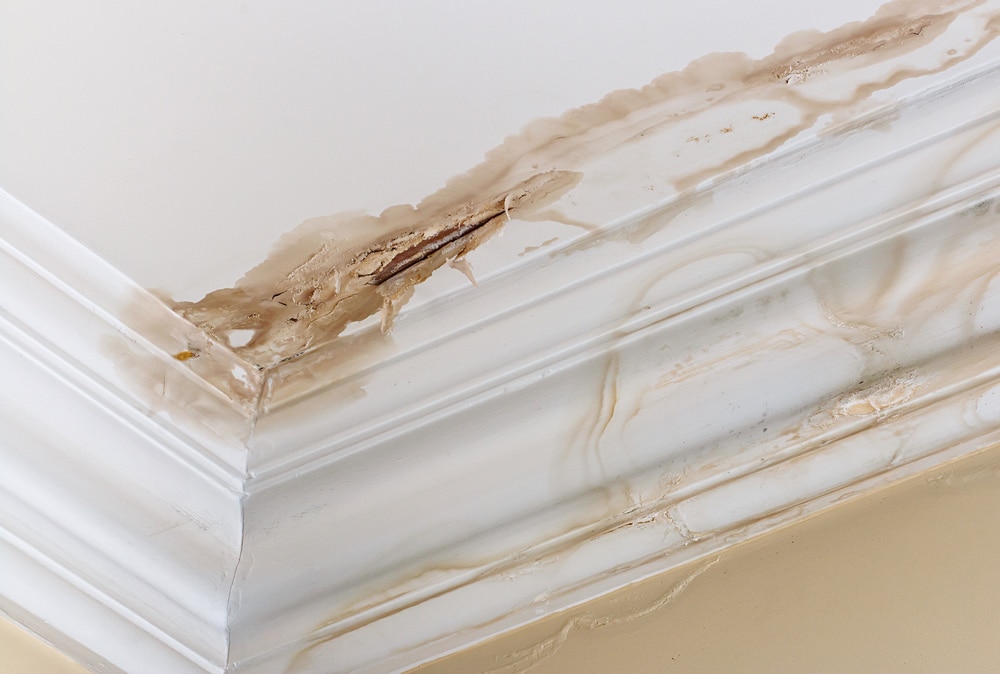Water damage is a huge problem for homeowners. It can cause a lot of damage to your home and be expensive to repair. Below will discuss seven things you should look for if you believe your roof or ceiling may have been damaged by water. We will also provide some tips on how to prevent water damage in the future.

1. Water Stains on The Roof and Ceiling
If you look up at your ceiling and notice any water spots, there is most likely a water leak somewhere in your roof. Stains caused by water are typically brown or yellow in colour and can take on a circular or oval form. If you notice any water stains on your ceiling, you should make an appointment with a roofing contractor as soon as possible so that they can inspect your roof.
2. Sagging Ceiling
The sagging of your ceiling is another indication that there is water damage in your home, so keep an eye out for it. A sagging roof may have been caused by a number of factors, but water damage is one of the most typical causes. If you notice that your ceiling is sagging, you should get in touch with a roofing contractor as soon as possible to have your roof inspected.
3. Bulging Drywalls
Drywall that has become water-logged is one of the most serious issues that can be caused by water damage. Drywall will start to swell and bulge when it has absorbed an excessive amount of water. This can lead to the drywall crumbling apart and cracking, and it can also cause the paint to flake and peel off.
4. Mould and Mildew
Mould and mildew will take hold in your home as soon as the conditions inside become favourable enough for them to do so. Mould and mildew are both fungi, but there is a significant distinction. Mildew, in contrast to mould, which can permeate whatever surface it inhabits, typically takes the form of a patch that is flat, white to grey, and appears on characters where there is moisture. Mould is very similar to mildew, but it poses a more significant threat to the structure of your home if it is allowed to grow. Mildew can only cause cosmetic issues. Mould can spread across and even within a material, such as wood or paper, and as it does so, it deteriorates the material it is growing on. If your roof leaks into a wall space, it may create the ideal conditions for mould to thrive. Mould can spread quickly through moist environments.
5. Discoloured Ceiling
Discolouration of the ceiling is another clear indication that the roof has been damaged. A damaged roof allows water to enter the building, soaking the insulation and seeping through to the ceiling. After that, a gradual colour change will occur as a result. It’s possible that a hole in your roof is to blame for the discolouration on the ceiling of one of your upper rooms. Because of that hole, your insulation will start to become less effective.
6. Blistered or Peeling Paint
When precipitation makes its way onto a property, it must exit via another route. Rainwater will make its way down the roof beams and into the insulation, flow onto the ceilings, and finally make its way down into the wall spaces. Your walls’ paint will eventually blister and flake off due to the accumulation of wet days over time, which will cause the walls’ overall condition to deteriorate. The conditions inside your wall space will also become humid, making the problem even worse.
7. Light Penetration Into Your Roof Space
Even though this is a fairly obvious sign that there is damage to the roof, it is possible that you will not notice it unless you go up into your attic or roof space and turn off all of the lights. The underlay or flashing has been compromised if you can see the light penetrating the roof. On a day with significant precipitation, a hole of any size will still let a substantial amount of water through it, regardless of how small the hole appears.
The presence of water dripping from the ceiling is typically an indication of a problem with either the plumbing or the roof. The majority of ceiling water damage is caused by slow leaks, which result in water spots that are yellowish-brown in colour. Even though water stains on the ceiling might not appear to be a particularly urgent problem, a major leak could cause water to pour through your ceiling in a matter of minutes.
If you want to prevent water damage in the future, you should make sure that your gutters are clean and free of debris. You should also ensure that your downspouts are directed away from home. If you have any questions about preventing water damage, you should call a roofing contractor to come and inspect your roof as soon as possible.






